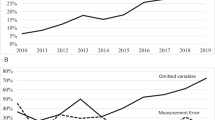Abstract
Problems of specifying a proper functional form for estimating sales tax revenues of a state are discussed. A general functional form is introduced, in which linear and log-linear forms are special cases. The maximum likelihood approach and data for Tennessee are used to estimate parameters in the general form. Empirical results disclose that the null hypotheses indicating the functional form is linear or log-linear are both rejected. The best functional form obtained from the general form provides not only better R2 and Durbin-Watson statistic, but also generates estimates of sales tax collections with smaller errors than the linear and log-linear forms.
Similar content being viewed by others
References
Adams, F. G., C. G. Brooking and H. J. Glickman, “On the Specification and Simulation of a Regional Econometric Model: A Model of Mississippi,”Review of Economics and Statistics, Vol. 53 (1975), pp. 286–298.
Box, G. E. P., and C. R. Cox, “An Analysis of Transformations,”Journal of Royal Statistical Society, Series B, Vol. 26 (1964), pp. 211–243.
Chang, H. S., “A Computer Program for Box-Cox Transformation and Estimation Technique,”Econometrica, vol. 45 (October 1977), p. 1743.
—, “Functional Forms and the Demand for Meat in the United States,”Review of Economics and Statistics, Vol. 59 (1977), pp. 355–359.
—,Tennessee Econometric Model: Phase I, Center for Business and Economic Research, University of Tennessee, Knoxville, March 1976.
Friedlaender, A.F., G. J. Swanson and J. F. Due, “Estimating Income and Sales Tax Revenue Changes in Response to Changes in Personal Income and Sales Tax Rates,”National Tax Journal, Vol. 26 (1973), pp. 103–113.
Granger, C. W. J. and P. Newbold, “The Use of R2 to Determine the Appropriate Transformation of Regression Variables,”Journal of Econometrics, Vol. 4 (1976), pp. 205–210.
Howrey, E. P., L. R. Klein and M. D. McCarthy, “Notes of Testing the Predictive Performance of Econometric Models,”International Economic Review, Vol. 15 (1974), pp. 366–383.
J. Kmenta,Elements of Econometrics, New York, The Macmillan Company, 1971.
Legler, J.B. and P. Shapiro, “The Responsiveness of State Tax Revenue to Economic Growth,”National Tax Journal, Vol. 21 (1968), pp. 46–56.
Zarembka, P. “Transformation of Variables in Econometrics,” in P. Zarembka (ed.),Frontiers in Econometrics, New York, Academic Press, 1974.
Author information
Authors and Affiliations
Additional information
The author would like to thank Professor Charles B. Garrison for helpful editorial suggestions, which resulted in improvement in the presentation of the paper.
Rights and permissions
About this article
Cite this article
Chang, H.S. Functional forms and the estimation of a state's sales tax revenue: Tennessee as a case study. Ann Reg Sci 13, 8–18 (1979). https://doi.org/10.1007/BF01284776
Issue Date:
DOI: https://doi.org/10.1007/BF01284776




